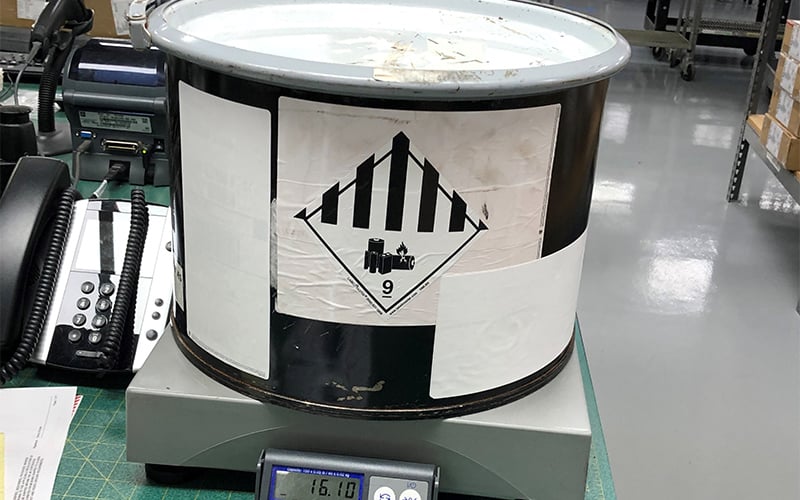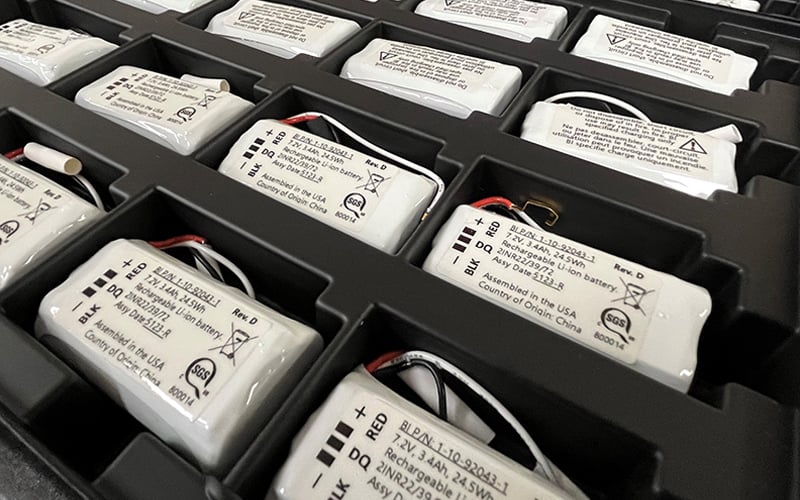Lithium batteries are used in the majority of the high-powered devices used today. From vehicles to cell phones, these batteries come in a range of sizes, watt-hours, chemistry, and volume.
Manufacturers will design and ship these batteries as packs by themselves, pre-installed inside devices, or in the same package as with the device. Whether you are shipping batteries by airplane, ocean vessel, delivery truck, or train, both national and international shipping restrictions must be followed.
Why Are There Regulations for the Transport of Batteries?
Lithium cells and batteries are classified as hazardous materials by transportation regulatory organizations. They contain an electrolyte that can become flammable or corrosive. This electrolyte also contains very high density and can easily become unstable, leading to overheating of the cell. A short circuit from the electrical connections may also cause the electrolyte to ignite. These issues could lead to battery pack damage, damage to the device it is installed, and other physical damage.
Due to being considered hazardous, the battery falls under hazardous materials regulations under the U.S. Department of Transportation (DOT) and is subject to shipping restrictions. These restrictions will be based on how they are shipped and the mode of transportation. Other organizations that will have shipping restrictions for lithium-based batteries include the International Maritime Organization's (IMO) Dangerous Goods Code and the International Civil Aviation Organization's (ICAO) Technical Instructions for the Safe Transport of Dangerous Goods by Air.
Special Shipping Practices for Batteries
Not every battery chemistry requires shipping regulations. Alkaline batteries can be shipped under normal circumstances. Yet lithium metal and lithium-ion battery packs and cells fall under the regulations. Also, prototype lithium batteries have special packaging requirements.

Lithium prototype battery pack shipping container class 9 hazardous.
To ship batteries, workers will need to have International Air Transport Association certification when a manufacturer plans to ship the batteries over air. The certification covers workers who will be handling, placing on shipping labels, and managing battery packages of lithium batteries.
Keep in mind that there may be other certifications or regulating organizations that have special requirements, especially when shipping lithium batteries to other countries, such as the United Nations Economic Commission for Europe. To keep updated on regulations, individuals can visit the websites of regulatory agencies to review information. They can also learn about regulations from the battery pack manufacturer. Battery pack manufacturers take steps to keep in compliance with national and international standards, as they can provide the latest information on when these standards may be modified or amended.
If an individual is using national shipping companies (FedEx, UPS, USPS), they will also have requirements and restrictions for lithium batteries. Visiting these couriers’ websites or contacting them directly will allow you to learn greater details about their requirements so you can package the batteries and cells correctly. You may also check with a specific shipping carrier, such as an airline or rail line, for their specific standards.
Packaging Requirements for Lithium Batteries
Lithium batteries shipped using commercial marine vessels will follow technical instructions provided by ICAO. This regulation also applies to batteries with their devices shipped by rail or truck before and after they are shipped by aircraft. General shipping practices that you will encounter for lithium batteries are as follows:
- Any package that contains lithium or cells, whether shipped individually or with a device, should have a shipping label identifying that it contains a lithium battery as well as being marked as a hazardous good.
- Lithium batteries need to be packaged to prevent any short circuits from the electrical connections.
- Defective or damaged lithium batteries should never be shipped under any circumstances.
- Lithium batteries that are shipped back to the manufacturer for recycling cannot be transported by air unless receiving approval from the airline or other air travel authority.
If the lithium battery weighs more than 35 kilograms, the package must be approved by the national agency. Packages may carry up to a weight limit of 35 kilograms for lithium metal cells that have more than 1 gram of lithium and batteries that have more than 2 grams of lithium, as well as lithium-ion cells that are greater than 20Wh and batteries greater than 100Wh that are loose, packed in devices, or inside a device package.
Lithium-ion batteries and cells that have less than 100Wh or 20Wh respectively have a weight limit of 10 kilograms per package when shipped at high volume and 5-kilogram weight limits when shipped at low volumes.

Certified lithium batteries packaged below 10-kilogram weight limit.
In January 2023, updated revisions to the Hazardous Materials Regulation (HMR) standards took effect for lithium batteries. Lithium batteries and cells shipped alone or have a weight of over 5 kilograms when shipped inside devices or with devices must have a Cargo Aircraft Only (CAO) label for all modes of transportation. Other revisions involve banning the transportation of lithium batteries and cells in passenger aircraft when marked as cargo, and lithium batteries and cells must limit the state of charge (SoC) to 30% when shipped alone inside cargo-only aircraft. This last provision does not apply to batteries or cells shipped inside or with devices.
There is also now an exception to the number of batteries that can be shipped for medical devices. Shippers may place a maximum of two replacement batteries or cells with the device when shipping it out as cargo on passenger aircraft after receiving approval from the U.S. Pipeline and Hazardous Materials Administration (PHMSA). The batteries or cells should still abide by the 30% SoC requirements unless meeting certain provisions.
Summary
Individuals who plan to ship lithium metal or lithium-ion batteries should review all regulations and special shipping conditions to avoid penalties and fines. Also, any changes to the PHMSA standards may not align with standards developed in other countries. So, U.S. shippers should still contact and follow international special shipping standards when transporting lithium batteries and cells out of the country.
Key Takeaways
- Lithium batteries are classified as hazardous materials: Due to their flammable electrolyte and potential instability, lithium batteries must comply with strict national and international shipping regulations to prevent safety hazards.
- Different transport modes have unique restrictions: Shipping lithium batteries via air, sea, rail, or truck comes with specific limitations, including Cargo Aircraft Only (CAO) labels, weight limits, and charge state restrictions.
- Proper packaging and labeling are essential: Lithium batteries must be packaged to prevent short circuits, labeled as hazardous goods, and meet weight restrictions based on their watt-hour (Wh) rating.
- New 2023 regulations impose stricter controls: Updated Hazardous Materials Regulations (HMR) include passenger aircraft bans, 30% state of charge limits for cargo aircraft, and exceptions for medical device batteries.
- Compliance with shipping carrier policies is necessary: FedEx, UPS, USPS, and other couriers have specific lithium battery shipping requirements, so shippers must verify regulations before transport.
















